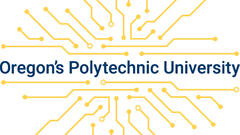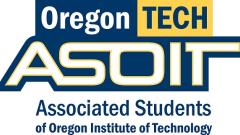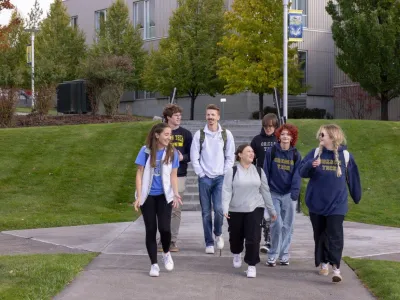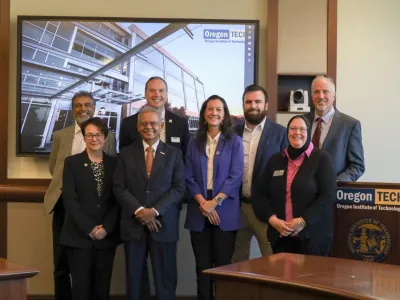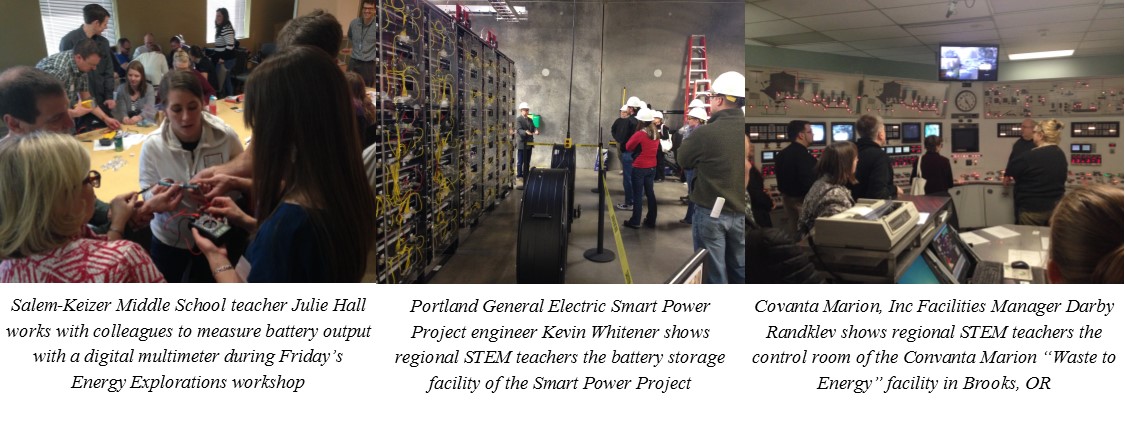
Jan. 21, 2015, Salem, OR-On Friday, January 16, middle and high school teachers from Salem-Keizer, Dallas, and Newberg school districts connected science, technology, engineering, and math (STEM) to the real-world through tours of three energy industry worksites. As part of an effort by the South Metro-Salem STEM Partnership (SMSP), teachers toured energy industry sites including Sanyo Solar of Oregon, Portland General Electric’s Salem Smart Power Center, and Covanta Marion, Inc. to see STEM in action in our region’s energy economy. The tours are part of an effort by SMSP to give teachers the experiences necessary to make STEM education real and relevant in the classroom for their students. Oregon Institute of Technology hosts the SMSP on its Wilsonville campus and provides in-kind support in comprehensive ways to advance the goals of the Partnership.
The STEM teachers learned how solar panels are made, how renewable energy may be stored in the future, and how Marion County’s trash is converted to energy for the region. Probably most importantly, teachers were exposed to the wide array of STEM degrees and skills that students need to take part in these industries. Teachers put their hosts to the test, firing questions that ranged from geology to materials science to algebra to political science and policy, trying to connect new information to the curricula they teach in their classrooms every day.
In the afternoon, teachers dug into what this new knowledge could mean in their classrooms. Crossler Middle School (Salem) teacher Mark Madsen shared with his colleagues a unit he developed on solar energy. The unit combines hands-on labs in which students collaborate to learn to assess energy output with technology, such as multimeters; determine the ideal position for solar panels in a model system comprised of milk-carton houses and miniature solar panels; conduct cost-benefit analysis of installing solar on their school and own homes using web-based computer software; and a “final exam” in which students demonstrate critical thinking and argument through a culminating letter to the school principal, persuading him why Crossler Middle School should (or should not!) invest in solar panels. Mr. Madsen’s unit includes guest speakers from Sanyo Solar of Oregon and Portland General Electric.
Later in the day, Seaside High School teacher Luke Robbins introduced a lesson on optimizing configurations of miniature solar panels to charge batteries to store the maximum amount of energy. Participants worked in teams, trying (and often failing) to create the right combination of components, learning to troubleshoot the system, and occasionally making impromptu discoveries of electrical safety. More than one teacher was overheard saying “Whoa! That’s getting pretty hot!”
Mr. Robbins also shared a philosophy that many agree is critical to student learning: “Students have to know it is okay to fail. They just have to keep trying.”
A portion of a $17,500 grant from Portland General Electric Foundation supplied materials for all participants to take the solar lessons back to try in their own classrooms. The PGE Foundation has partnered with the South Metro-Salem STEM Partnership and Oregon Institute of Technology to support STEM education in this part of the state. The project is part of a larger partnership effort to help teachers understand and teach STEM in the context of real-world problems. STEMOregon Connections is being developed by the partnership as a key strategy for connecting teachers to the broader STEM community.
“PGE is pleased to take part in many different types of STEM learning opportunities, because the future is brighter when our students are properly prepared,” said Kregg Arntson, executive director of the PGE Foundation. “Our community is positively impacted by the success of our teachers and students.”
The SMSP is a collaborative of community leaders, representing 15 school districts, 7 higher education institutions, 11 industry partners, and 14 community organizations, all committed to engaging students in authentic, inspiring science, technology, engineering, and math (STEM) education. The PGEF grant creates opportunities for teachers to see STEM in action in the real world, empowering them to engage their students in authentic learning opportunities that are connected to the real world and Oregon’s economy.
For further information contact Melissa Dubois at 503-821-1169 or Melissa.Dubois@oit.edu.
About the South Metro-Salem STEM Partnership
The SMS STEM Partnership is a collaborative of community leaders, representing 15 school districts, 7 higher education institutions, 11 industry partners and 14 community organizations, with a vision to catalyze Oregon students to achieve STEM degrees and certificates, and reach Oregon’s education goals by increasing the access, excitement and engagement of students in STEM courses and experiential learning. The Partnership is hosted on the Oregon Institute of Technology’s Wilsonville campus, which provides a variety of in-kind support to ensure success for students. For more information, contact Melissa Dubois, SMS STEM Hub Director, at melissa.dubois@oit.edu or www.oit.edu/stem or www.stemoregon.org.
About Oregon Tech
Founded in Klamath Falls in 1947, Oregon Institute of Technology is the only public 4-year institute of technology in the Pacific Northwest. Oregon Tech provides degree programs in engineering and health technologies, management, communication, and applied sciences that prepare students to be effective participants in their professional, public, and international communities through hands-on learning. Oregon Tech has a full-service, residential campus in Klamath Falls and an urban, industry-focused campus in Wilsonville. Visit www.oit.edu to learn more about Oregon Institute of Technology.
About Portland General Electric’s Salem Smart Power Center
The Salem Smart Power Center offers visitors a behind-the-scenes look at a working smart grid demonstration project. The center is testing how groundbreaking smart grid technologies – including large-scale energy storage – can work together to help assure more sustainable, efficient, and reliable power for PGE customers.
The 8,000-square-foot facility in South Salem, Ore., features an educational center where visitors can see energy storage in action – testing how to store and better integrate variable renewable energy resources like solar and wind.
The Salem Smart Power Center Project is part of the five-year, $178 million, Pacific Northwest Smart Grid Demonstration Project – a collaborative and unique demonstration of unprecedented technologies across five Pacific NW states. The largest in the nation, the project involves more than 60,000 metered customers and is designed to move the region and the nation closer to establishing a more efficient and effective electricity infrastructure.
About Covanta Marion, Inc. Energy-from-Waste Facility
Covanta Marion, Inc., Brooks, Oregon
The Marion County Energy-from-Waste facility began commercial operation in March 1987, serving the solid waste management needs of the 300,000 people of Marion County, Oregon. The facility processes 550 tons per day of municipal solid waste (MSW), which generates up to 13.1 megawatts of renewable energy sold to Portland General Electric. The facility was the first mass-burn waterwall resource recovery facility combusting MSW in the United States to use dry flue gas scrubbers and fabric filter baghouses to control acid gases and particulates.
Notably, the facility has been a member of Oregon's safety and health recognition program, the Safety and Health Achievement Recognition Program (SHARP) Alliance, since 2006 and an Occupational Health and Safety Association (OSHA) Voluntary Protection Program (VPP) Star member since 2008.
About SANYO Solar of Oregon
SANYO Solar of Oregon LLC (an affiliate of Panasonic Corporation of North America) began operations in 2010 in Salem, Oregon. It is a manufacturer of premium quality silicon ingots, the basic component of photovoltaic solar panels. The plant employs nearly 150 people engaged in the growing and shaping of the ingots.
About Panasonic Corporation of North America
Panasonic Corporation of North America provides a broad line of digital and other electronics products and solutions for consumer, business, and industrial use. The company is the principal North American subsidiary of Osaka, Japan-based Panasonic Corporation and the hub of Panasonic’s U.S. branding, marketing, sales, service and R&D operations. In Interbrand’s 2014 annual “Best Global Green Brands” report, Panasonic ranked number five overall and the top electronics brand in the report. As part of continuing sustainability efforts, Panasonic Corporation of North America relocated its headquarters to a new facility, adjacent to Newark Penn Station in Newark, NJ. It is the first newly-constructed office tower in Newark to earn both LEED Platinum and Gold certifications from the U.S. Green Building Council. Learn more about Panasonic at panasonic.com/pressroom.

